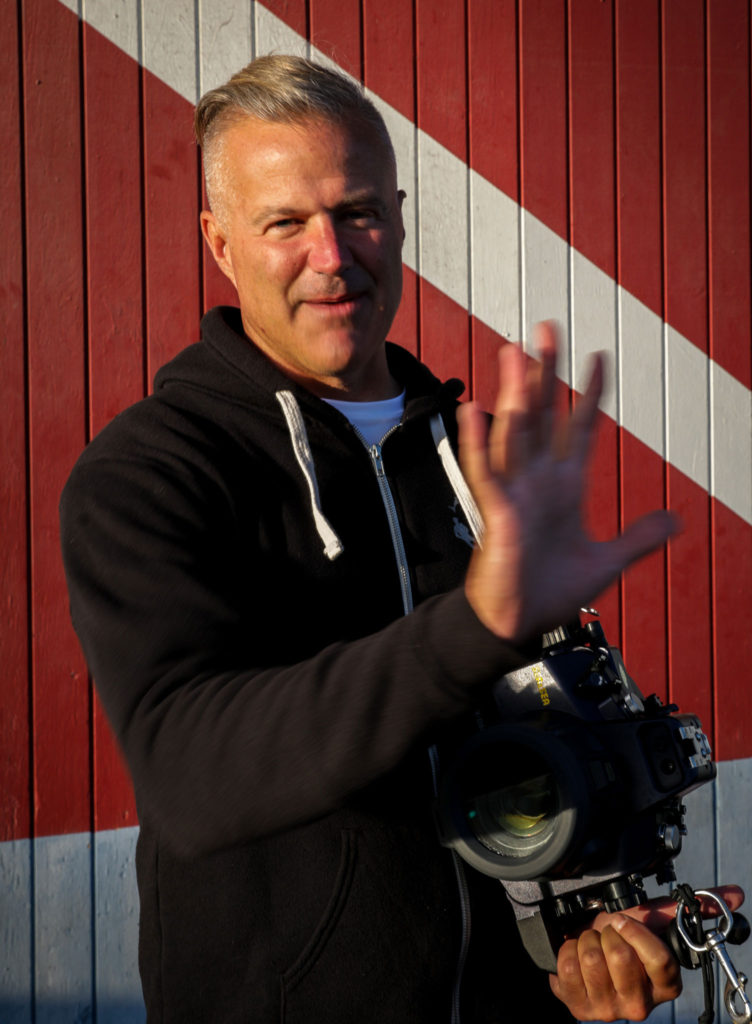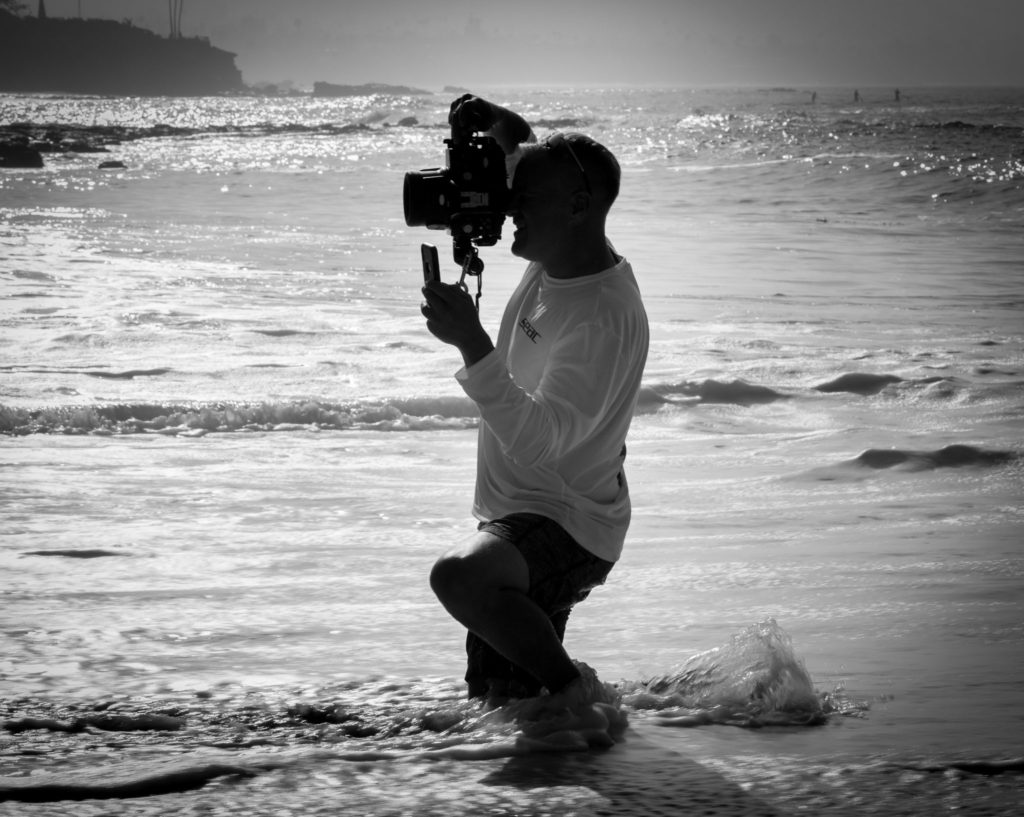Bill Carroll is on a mission. It includes the ocean and getting you into it. Because, in his words, “If you’re not in the ocean, you’re less likely to protect it.”
Bill is a diving instructor, marketing manager and tireless environmental action enthusiast for Beach Cities Scuba – a chain of dive centers in Southern California, and one of around 350 “100% AWARE” Partners of Project AWARE worldwide. I was introduced to Bill by Danna Moore of Project AWARE during AWARE Week—Project AWARE’s inaugural celebration of everything that divers do out of their love of the sea.
Project AWARE is the environmental NGO for divers that was born out of the Professional Association of Diving Instructors (PADI) in 1989. 100% AWARE is Project AWARE’s mechanism for harmonizing their relationships with dive operators around the world. Operators in the program promote Project AWARE’s agenda and, in return, they can access Project AWARE’s branding and participate in the organization’s signature activities – notably Dive Against Debris, Adopt A Dive Site, and now AWARE Week.

On the face of it this may not seem like a fantastic deal for dive operators. They pay an often tax-deductible fee to include AWARE Diver certification as part of their normal PADI certification process; they rally the community in their area; they do the organization and promotion at sea-level. So, what do they get in return?
The answer is: more than you might think.
Good divers, at the very least, dive responsibly and, these days, many want to take voluntary action to help preserve the underwater environment. The AWARE Diver certification builds this into the new diver’s psyche in a more concrete way, turning every diver who takes it into a potential underwater environmentalist.
Diving, like many things worth doing, is not all fun and games, particularly at the beginning.
Not all conservation actions taken by divers involve actual diving, but many do. In 2017 alone, fourteen hundred hours of diving for Dive Against Debris took place worldwide – and diving is the product that operators are in the business of providing.
Activities like Dive Against Debris get divers into the water and, when divers get into the water, dive operators get to fill dive boats, rent equipment and keep divers on the path to achieving new certifications. This, in turn, gets divers into new areas of the sport that require new equipment and leads to more diving fun.
It’s a virtuous cycle of supply and demand, where demand for conservation action instilled into the minds of divers leads directly to opportunities for dive operators to build their diving community and supply services and equipment.
It doesn’t end there, either.
The data collected by divers during Project AWARE activities can be used, with backing from the Project AWARE team, to engage local policymakers on making changes that are pro-environment, and therefore pro diving. After all, a big reason why divers dive is to explore a pristine ocean environment full of life.
So what does this mean for someone like Bill?
It means opportunity. Opportunity to take conservation action, create new ocean conservationists and, crucially, the opportunity to tell the story of how it was done.
A Personal Journey
Diving, like many things worth doing, is not all fun and games, particularly at the beginning.
It’s an adventure sport. The risks are real. There is equipment to master, skills to acquire, and moments of discomfort while you’re coming to terms with it all.
Bill knows better than most the challenges that some people face when they feel the call to learn how to dive because, as a diving instructor, he has witnessed them more than most. He has trained hundreds of people in his career and can relate stories of getting students in touch with their inner diving “badass,” a shorthand for working with people to give them the determination to overcome obstacles and succeed.
Before long, he found that everything he was doing was bringing him to a new focus: conservation action.
And, he has the confidence of someone who knows that the rewards of becoming a diver are immense – giving those who do it access to a universe full of wonder that relatively few are privileged to experience.

Bill began in the Navy and worked as a diving instructor to put himself through college. Work in the corporate world followed but didn’t satisfy him. Getting back into teaching scuba gave him renewed purpose – a revived sense that he was getting better as a person every day.
That realization brought him to California, where he began taking a GoPro camera with him on every training dive.
His initial idea was that he was going to use the GoPro to tell his own story, inspiring people to dive as he did so, but along the way he discovered that what really got him excited was telling the stories of his students.
He was soon picked up by Beach Cities Scuba, who gave him the mandate to promote the chain across multiple channels. Before long, he found that everything he was doing was bringing him to a new focus: conservation action. A new realization that this was his true responsibility and motivation—his “why.”
Conservation action followed, as well as a closer alignment with Project AWARE. Beach Cities Scuba took a key role in the Newport Harbor Underwater Cleanup – an action involving hundreds of divers, attracting corporate sponsors and government support and collecting 1900 kilograms (4,200 pounds) of trash from the ocean.
The Empowerment Business
Bill is in the empowerment business. With his help, Beach Cities Scuba takes people who long to be in the ocean and makes their dream come true. His goal is always to turn them into stewards of the ocean as he teaches them to dive, and to tell the stories of conservation action that follow to the world via the combined networks of Beach Cities Scuba, Project AWARE
“I love seeing Leonardo di Caprio take on what he’s doing,” He says “You’ve got Dr. Sylvia Earle and her Hope Spots—these are big projects, lofty goals, high minded stuff—in addition to that we need people on the ground, actually teaching other people how to pick up the trash…people in action on a daily basis, creating these programs, bolting them in and showing other people how to do it.”
Real-world conservation considers the need for people to survive and thrive.
Bill now places his emphasis on the need for powerful storytelling. From his point of view, as important as individual actions are, we have to tell the story. He believes that this is the only way we can bring empowerment to enough people to make the necessary difference—to scale the effort up to adequate levels; to ensure that environmental action gets repeated over and over again across the world for decades to come.
Next, Bill’s sights are set on taking his efforts south into Mexico’s Baja California Peninsula. He has developed a relationship with the El Vizcaino Biosphere Reserve with the goal of bringing underwater cleanup efforts—reef checks and Dive Against Debris—to Bahia Asuncion on the peninsula’s West Coast.
His aim is for this project to have a much more organized and professional storytelling component to it, including the use of film and TV professionals with a track record of high quality underwater and documentary work.
The Mexican government has shown interest in supporting conservation efforts in the area and with the support of the Biosphere he has high hopes. PADI have agreed to provide course materials for free.
As always though, when you start to look at taking conservation efforts into new areas, socio-economic issues quickly come to the surface.
His hope is that by starting conservation efforts in Bahia Asuncion, he will spark a new direction that will help to develop ecotourism in the area and—following the Project AWARE model—permanently link diving and ocean stewardship with a brighter socio-economic future for the people who live there.
Ecotourism, including diving, comes with its own negative impacts, of course; impacts that The Sealives Initiative will document in other profiles. It’s never a completely positive picture. Real-world conservation considers the need for people to survive and thrive. Unfortunately, for now at least, where there are people, there will always be damage; even if that damage is limited by responsible behavior and mitigated by good works.
One person’s solution (diving tourism for instance) is another’s emergent problem (boat noise and reef damage). But these are complications that we have to figure out as we go along.
For now, boats are driven by noisy and potentially dangerous motors—and the trash in the ocean isn’t going to get rid of itself—but electric boats do exist that may one day evolve to more powerful and versatile machines. Electric boat manufacturer Duffy Boats is a sponsor of the Newport Harbour clean-up, and, speaking for Scuba Cities, Bill tells me they always push for the most conservation-minded approach possible.
“The universe doesn’t move for the actor, it only moves for the act.”
As for Bill, he’s focusing on marine debris for now, rather than a wider range of conservation issues. And he is expecting to learn a lot during this first project to spark efforts in a new geographical area. Whatever happens, he is passionate about telling the story of it all to a wider audience.
The Story’s The Thing
“If I’m gonna make a difference, where I’m going to make a difference is as a storyteller. I teach people to dive. I teach people how to walk on the other 71% of the planet. I can teach people how to dive all day long, and I can instill my passion in those people, for ocean conservation […] but if I can be a storyteller on a bigger scale, that’s where I’m going to make an impact. That’s where my legacy will be—being able to teach people there is another way. I think that’s my obligation.”
“The universe doesn’t move for the actor, it only moves for the act,” he tells me. “We get to make the story. Let’s tell a more beautiful story. That’s our job.”
If all plays out the way he wants it to, Bill’s long-term vision is to take his model of rapid conservation expansion and storytelling to a new location every month.
This goal speaks volumes about Bill’s energy and how telling the story of ocean conservation through direct action drives him. As he puts it: “It’s that relentless pursuit […] It’s the ‘why’”
“Waking up at five in the morning, or four in the morning, or three in the morning may seem like a huge pain in the ass. And if you don’t have a ‘why’ to do it, you’re not going to do it. But for the right ‘why,’ you’re willing to cross any river, go over any obstacle, or do any amount of hard work. Whatever it takes.”
That is his ‘why’ and that is his mission, and it includes you and me and many more besides.


